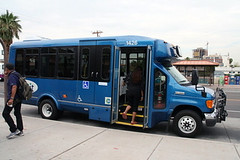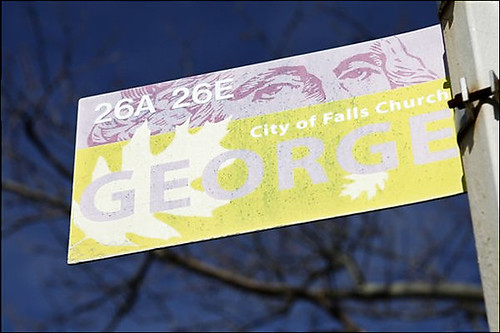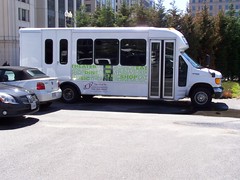Earth Day and Intra-neighborhood transit

Orbit bus, Tempe, Arizona. Photo: Venus Lee/The Arizona Republic. Hundreds of people have signed petitions, sent e-mails and made phone calls voicing opinions about if and where free shuttle service should be expanded throughout the northern half of Tempe.
In a paper I wrote a couple years ago, among other things I proposed intra-neighborhood transit designed to move people in and around a neighborhood, and to major transit stations and lines, without their having to drive. (E.g., it is a big problem in neighborhoods with transit stations when people with Ward parking stickers drive to the station area and park, taking up all-day spaces.)
In the context of what I call the Metropolitan Transit Network, I call this type of service part of what could be termed the DC Tertiary Transit Network.
It turns out that Tempe Arizona has refigured part of its bus service to do exactly that. See the Tempe In Motion (the city's Department of Transportation) website for information on the Orbit bus system as well as these articles (no longer available for free) from the Arizona Gazette, "Neighborhood circulator buses bring sense of community" and "Venus, Mercury bus routes are in Tempe's Orbit circulation."
From the Orbit webpage:
Orbit (a FREE service) uses mini-buses to serve residential areas and connect them to local destinations such as shopping areas, other neighborhoods, major bus routes, schools and multi-generational centers. All Orbit routes run from 6 a.m. to 10 p.m. every 15 minutes, 7 days a week. "No stop zones" occur in between the crosswalks of all schools served by an Orbit route. The Orbit routes use “flag” stops, which means that the driver will pick up and drop off passengers in residential neighborhoods provided it is safe to do so.
Note that the Tempe In Motion website is another example of a best practice government agency transportation website, focused on mobility, not just transit.
Scottsdale, Arizona has introduced a similar service.
And you could argue that the GEORGE service within Falls Church, Virginia does the same thing. But the Washington Post believes it is a luxury service and ought to be dropped for financial reasons. See the editorial, "A Bus to Nowhere: In Falls Church, a transit boondoggle."
Now the problem, likely with the GEORGE Service has more to do with population density and limited number of activity centers within the city. Rather than dump it, figure out how to make it work first. Maybe it can't work based on the conditions of transit demand within the city. But figure that out first. The Associated Press ran a story on the bus service, "INSIDE WASHINGTON: Pricey bus test a bust," which wasn't favorable, but it focused on the fact that the system was funded by earmarks.

The sign for the GEORGE bus line is seen at the East Falls Church metro stop in Arlington, Va. on Wednesday, April 8, 2009. It seemed like a good idea to its proponents, perhaps one that could be emulated nationwide: a fleet of electric buses that would ease congestion in one of metropolitan Washington's traffic-choked suburbs and do it in an environmentally friendly way. (AP Photo/Jacquelyn Martin)
I don't know if Falls Church has done the kind of transportation demand management planning done in adjoining Arlington County, but it would be "fascinating" to do a study there, a full "TravelSmart" survey of each household, and figure out how to best make transit work.

But the survey would have to be much deeper, concerning travel behavior for the entire household for the entire day, not just for trips to/from work. The model would be the TravelSmart Australia program (first piloted in Victoria, see TravelSmart), which looks at all trips, not just work trips, albeit focused on major trip generators. From the website:
Many organisations are "trip-generators", which mean that the needs or desires of people to get to there, whether as a worker, a shopper or a student, cause frequent trips and visits by large numbers of people.
The types of organisations that generate frequent travel by many people include: places of employment, hospitals, schools, universities, sports & entertainment venues, commercial centers and supermarkets. Your organisation or community can become TravelSmart by using ideas from the national toolkits as they are available.
My sense is that during specific periods of the day, the George service may make a lot of sense, but not all day, when demand is likely to be extremely limited during time periods outside of rush hours in the morning and evening. But again there are other problems, if the transit service there competes with free parking, that makes it difficult. Plus, in the future, when the Silver Line subway system is in operation, it could be a completely different situation in terms of how such a service fits into the transitshed in Falls Church, and Fairfax and Loudoun Counties.

George bus. Photo: Adam Moreira via Wikipedia
But I am the first to agree that legislating bus service, be it the George bus service in Falls Church, or the DC Circulator service between Adams Morgan, Columbia Heights and Downtown (Ward 1) or between Union Station and the Navy Yard (Ward 6), or special shuttles that duplicate extant bus service (H Street NE), is the wrong way to go. It ends up disserving people who have limited transit options, who find these services limited, in periods of budget difficulty, such as people in the Oxon Hill area of Prince George's County, who face the loss of direct bus service to DC. See "5-Cent Hikes Better Than Bus Cut Idea, Many Riders Say" from the Post.

Bus, H Street Shuttle.
In a transportation plan for the city and region, there need to be hard numbers that proposed services have to meet, in order for the service to be able to be approved. And these requirements need to be hard, and impervious to legislative legerdemain and waste.
In any case, it is almost always a mistake to develop transit service without considering how it fits into a Metropolitan Transit Network. When service is created by legislation, you can almost always be assured that the service isn't viable otherwise.
Labels: transit service, transportation planning



0 Comments:
Post a Comment
<< Home